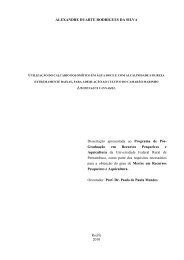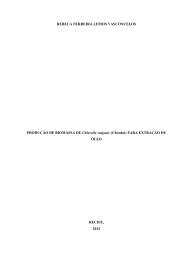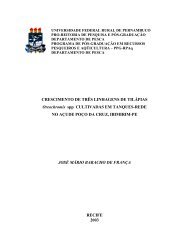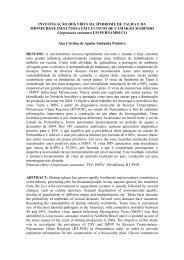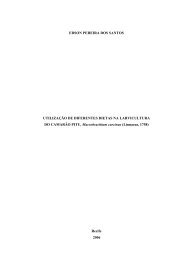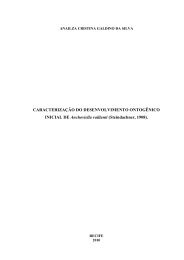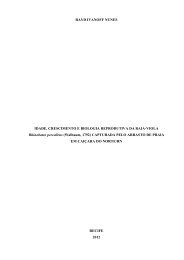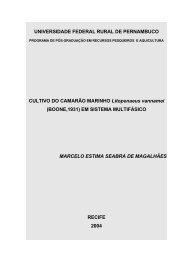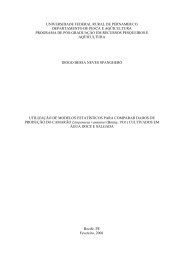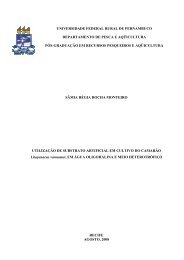Aspectos da biologia reprodutiva e padrões de ... - Pgpa.ufrpe.br
Aspectos da biologia reprodutiva e padrões de ... - Pgpa.ufrpe.br
Aspectos da biologia reprodutiva e padrões de ... - Pgpa.ufrpe.br
You also want an ePaper? Increase the reach of your titles
YUMPU automatically turns print PDFs into web optimized ePapers that Google loves.
XABSTRACTThis work was accomplished in the Aquiculture Experimental Station belong to theFisheries Department of the UFRPE and in the Fish culture Station of CHESF, PauloAfonso-BA, in the period between the year of 2001 and 2002. Aimed to study someaspects of the reproductive biology of the Nile-tilapia, Oreochromis niloticus, chitrala<strong>da</strong>strain, and the patterns of growth of its offspring in different experimental conditions.Initially, it was investigated the growth performance among sexually reverted and norevertedfish, in two offspring strains with patterns of growth <strong>de</strong>nominated type A and B.These offspring were a result of the <strong>br</strong>eeding crossing between the <strong>br</strong>oods fish, havingthe following patterning of growth: ♂A X ♀A and ♂A X ♀B. First, the growth wascompared among the reverted fish and no-reverted ones, insi<strong>de</strong> of each group andbetween them; a intra and inter-specific comparisons. Soon after, it was observed thegrowth of the successive strains from non-reverted fish stocks, a comparative study of thegrowth between males and females, and finally, the study of the sexual proportionalityfrom the same spawned fish. According to the results, there was not significant difference(P=5%) among reverted fish and no-reverted ones, as for the intra-groups (A with A and Bwith B) as well for the inter-group comparison (A and B). There was no statisticaldifference among the offspring F1 and F2 of no-reverted fish, and between the males andfemales, when they were cultivated in tanks. There was a difference in growth when themales cultivated in earthen pond were compared with those females reared tanks. Maleswere larger, statistically,. With relationship to the sexual proportionality insi<strong>de</strong> spawning, itwas noticed that the male was more predominant than the female, in a sexual proportionthat varied among 4:1 - 2:1. It could be conclu<strong>de</strong>d that non-reverted fish grew as much asthe reverted ones, in consequence of two factors: 1) the females grow as much as themales and 2) the number of males is always predominant over females in any spawning.The variables physical-chemistries of the water were consi<strong>de</strong>red in the normal conditionsfor the practice of fish culture. The group of tilapia Chitrala<strong>da</strong> here investigated is a strongcandi<strong>da</strong>te for the program of species selection based on AGV (Additive genetic variation),done in several parts of the world. It is recommen<strong>de</strong>d the effective control of this tilapiastrain and wi<strong>de</strong>r scientific observations, in or<strong>de</strong>r to verify the continuous effect of theresults obtained in this work.



